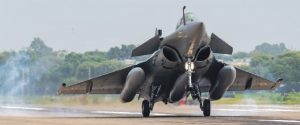 With the country’s first five Rafale fighter aircrafts arrival at Ambala air base (Haryana), the Director General, Inspection and Safety branch of the Indian Air Force (IAF) has asked the state government to check the garbage dumps around Ambala air force station over which flocks of birds like black kites and pigeons hover and thus pose a grave threat to the aircrafts.
With the country’s first five Rafale fighter aircrafts arrival at Ambala air base (Haryana), the Director General, Inspection and Safety branch of the Indian Air Force (IAF) has asked the state government to check the garbage dumps around Ambala air force station over which flocks of birds like black kites and pigeons hover and thus pose a grave threat to the aircrafts.
Stating that the safety and security of the Rafale aircraft inducted at Ambala on July 29 is the prime focus of the IAF, the DG, Inspection and Safety branch, IAF, Air Marshal Manavendra Singh has recently written to Haryana chief secretary Keshni Anand Arora pointedly stating that the air force station at Ambala has very high concentration of birds and this has the potential to cause very serious damage to the aircraft in case of a collision.
He has stated in his demi-official letter that the bird activity over the airfield is related to the presence of garbage in the area around. “Several measures have been recommended to reduce the same and the Air Officer Commanding Air Force Station, Ambala has met Joint Commissioner and Additional Municipal Commissioner of Ambala through Aerodrome Environment Management Committee meetings conducted on 24 January, 2019, 10 July, 2019 and 24 January, 2020’’, the letter says.
The letter goes on to point out that it is thus necessary that large and small birds are kept away from the airfield to protect the fighter aircrafts. The IAF has thus sought the immediate implementation of solid waste management (SWM) scheme to reduce the activity of large birds like black kites in the aerodrome zone of 10 km around the Ambala airfield.
“This would involve instituting to littering penalty, improvement in garbage collection and setting up of a suitable SWM plant at a suitable distance from the airfield,” the letter states seeking prohibition and control of pigeon breeding activity around the Ambala air force station.
Soliciting the support from the civil administration Air Marshal Manavendra Singh has further written that it is necessary that large and small birds are kept away from the airfield to protect the fighter aircraft and to meet this specific requirement of IAF.
The Air Marshal has also categorically sought Haryana government’s intervention in directing the Ambala local authorities to expedite the process “to save the irreplaceable asset of national import’’.
Work in progress
The Haryana government on its part has taken up the issue as “most urgent and time-bound’’ alerted the urban local bodies department asking it for immediate action. Even as the chief secretary has forwarded the IAF letter to the urban local bodies department for action, the local municipal corporation has started issuing notices to those persons who are breeding pigeons in the vicinity of Ambala IAF station and to take out their birds away by about 10 km area from the airbase.
Haryana home minister Anil Vij who also holds the urban local bodies (ULB) department says that he has asked the department to take a serious note of the menace and act swiftly as it is a matter of national import. “Since Ambala has not yet had its own solid waste management plant, I have directed the department to float tenders immediately for the same. Also, strict instructions have been issued to the ULB department to effectively check the pigeons breeding and the officials have also sent notices to some persons’’, he said.
Also, senior officials of the district administration say that it had also been decided to shift about six families involved in in pigeon breeding business of pigeon breeding in the area in close vicinity of the air base which falls in Ambala cantonment. It is also learnt that there are still a large number of people in the Ambala cantonment as well as Ambala city who were into business of pigeon breeding. Besides, it had also been decided to extend the ban on kite flying and private drones from three kilometres to four kilometres of the air base.
It may be recalled that though Ambala’s own SWM plant had been set up at Patvi village about 10 km from the airbase it has been lying non-functional since the past several years.
Recent instances of bird-hits
According to some reports bird-hits contribute to about 10% of accidents of fighter jets. The IAF sees the reasons of lack of bird-detection radars, manpower and importantly enough the garbage dumps around the air bases. The instances of bird-hits which have caused serious damage to IAF fighter jets at Ambala are not rare, either.
Sample these: In June, 2019, an IAF Jaguar fighter jet had to jettison its payload after it was hit by birds while taking off for a routine sortie from Ambala airbase. The off-loaded fuel tanks and practice bombs near the airfield and city’s Baldev Nagar’s residential, though providentially enough, no losses were reported.
Early in April, 2019, also two fuel-drop tanks were jettisoned by a Jaguar fighter jet pilot in empty agricultural fields at Rolan village in Ambala district after one of the engines of the aircraft suffered damage after colliding with some birds. The step to instantly jettisoning fuel tanks or other loads is taken to reduce jet’s weight thus enabling it for an emergency landing.
Similarly cases of bird hits at other air bases are also not new and major damage to a Sukhoi Su-30 MKI was also reported recently in Jodhpur in neighbouring Rajasthan. It is learnt that Jodhpur base alone has registered over 50 bird-hit cases in the past about five years. There have reportedly been similar reports of damage to fighter aircrafts from Gwalior air base, Tezpur base in Assam and Hasimara base in West Bengal.
The IAF, however, uses guns and crackers to scare away birds though the same cannot be a fail-safe method. India also has plans to procure bird-detection radars for the IAF and the Navy.
Importance of Ambala Air Base
Ambala is one of IAF’s frontline bases which played an active role during the Kargil conflict as the fighter aircraft Mirage 2000s were deployed here. The base has other fighter aircrafts such as the Jaguar strike aircraft and the MiG-21 Bisons at different times as per the requirement.
Of the six air commands in the country, Ambala air base falls in the western air command and is one of the most strategically important air bases to address threats over the borders from China and Pakistan.
The multi-role Rafale fighter aircraft have been based in Ambala because of the strategic location of the base. It is at an adequate distance from the Indo-Pak border for immediate mobilisation and conducting strikes against targets deep inside Pakistan. Ambala air base is also a perfect jump point for any air strike to be conducted along the northern borders with China.
letters@tehelka.com













